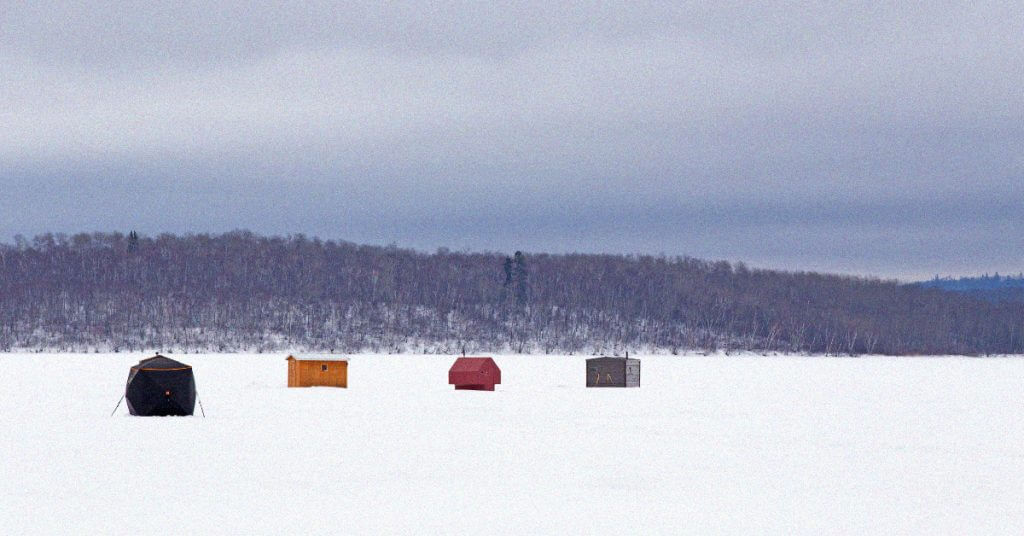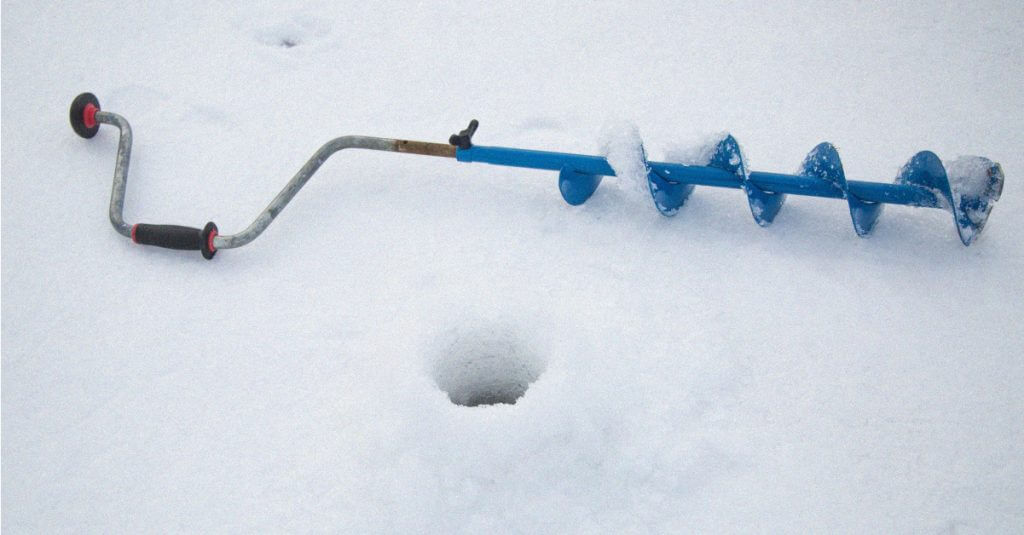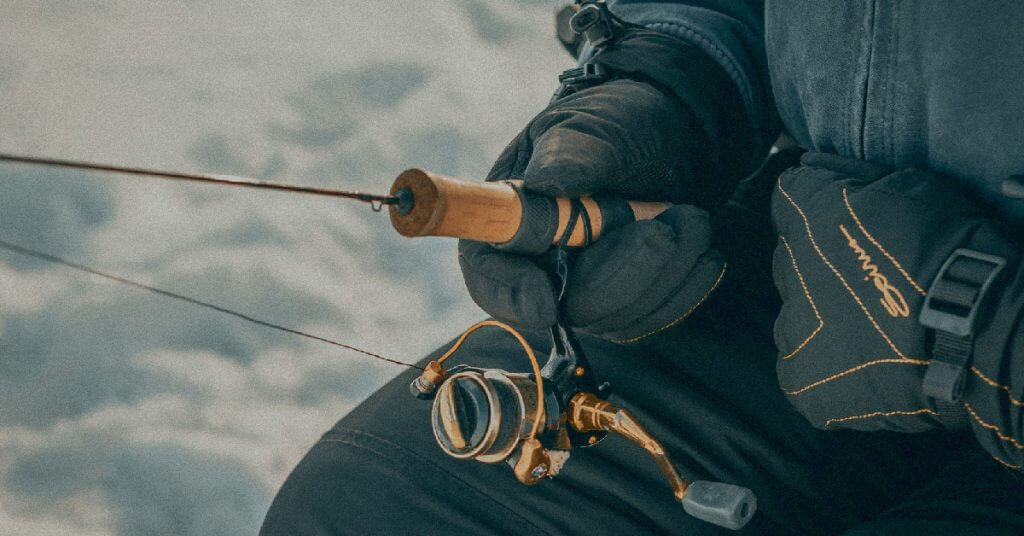Hard water fishing may sound exciting, but it can be dangerous.
Knowing and practicing ice fishing safety will reduce the danger, but ice fishing will never be completely safe.
The following ice fishing safety tips can make the difference between a fun outing and one that ends up being memorable for all the wrong reasons.
Table of Contents
1. Tell Someone You’re Going Ice Fishing
Most outdoor enthusiasts already know this essential tip for all outdoor activities. If you’re headed out to climb a mountain, you tell somebody.
Same with spelunking and hiking.
Ice fishing is no different.
You don’t have to invite them, but at least one person needs to know where you are and when you plan on returning.
If something happens to you— if your vehicle breaks down and strands you in the cold, or if you fall through the ice— search and rescue personnel will know where to begin their search.
That could be a matter of life and death.
Once you’ve made your plans and relayed them to a friend or family member, stick to the plan.
Don’t decide at the last minute to go somewhere else without letting someone know; if you decide to extend your time on the ice, find a way to let people know.
If you say you’ll return by 3:00 pm but change your mind, no one will know that unless you’ve told them, and they could assume the worst, mobilizing a rescue effort.
Bring your cell phone and use it.
2. Understand The Rules of Ice Thickness
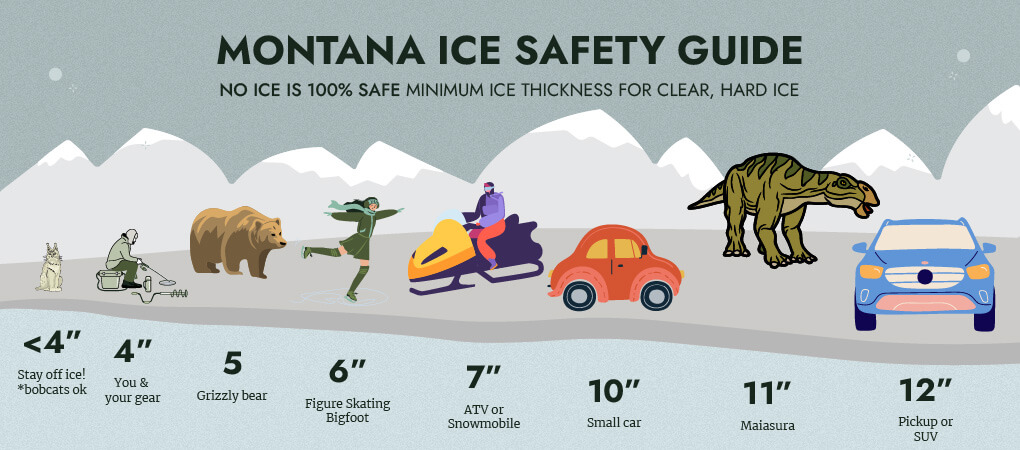
Whether you’re an old pro or an ice fishing noob, remember that ice is rarely uniform in its thickness and consistency.
While we have guidelines about the thickness of the ice, nothing is foolproof.
With ice on frozen lakes, ice anglers can usually rely on the following thicknesses and what they will support:
- Ice that is less than four inches thick: This thin ice will not reliably support you. Walking on the ice at this thickness— or any thickness of slush— is unsafe.
- Four inches of clear, fresh, white ice should support one adult.
- Five to seven inches of ice can support smaller vehicles like snowmobiles, ATVs, and small groups of people.
- Eight to 12 inches will support most cars.
- A small pickup to medium-sized truck can safely drive on ice 12 to 15 inches thick.
These ice thickness guidelines relate to clear, new ice and are only guidelines.
Water moving beneath the ice and snow on top of the ice can affect ice conditions, so be aware and exercise caution.
If it seems unsafe, assume it is and move to another location.
3. Don’t Fish Alone if You Don’t Have To
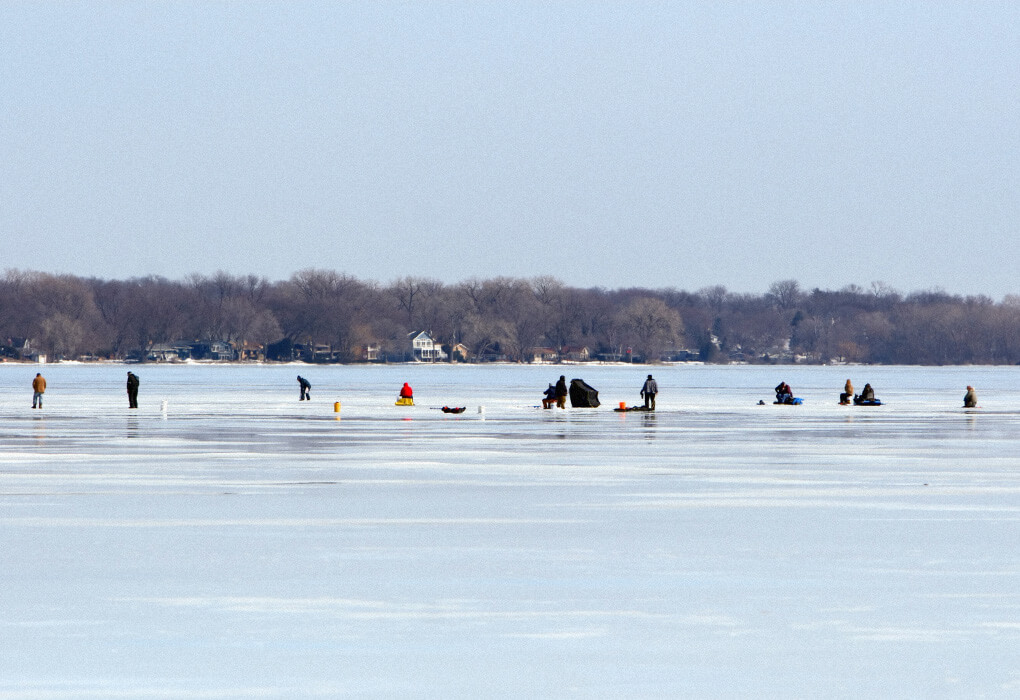
More directly, don’t fish alone. Ever. Wintery weather is dangerous.
Freezing temperatures are, too, and we haven’t even gotten to the whole standing-on-top-of-ice part.
Ice fishing by yourself is an invitation to disaster.
Worst case, you fall through the ice and into bone-numbingly cold water.
Hypothermia occurs when the body loses heat faster than it can produce, and water takes heat out of the body 25 times faster than air.
No one can overstate the dangers of hypothermia.
By fishing alone, you increase your chances of falling victim to circumstances that will give rise to this medical emergency.
Don’t go ice fishing by yourself.
4. Wear Ice Fishing Cleats

This safety tip seems like a no-brainer since just about everyone has slipped on a patch of ice before.
Ice is slippery (and hard).
If you schlep out onto the ice and fall, you’ve got a chance of cracking your head, breaking a bone, or opening up a gash somewhere on yourself.
Ice fishing cleats decrease the possibility of slipping, so take the time to find a good set and invest in them.
You wouldn’t go ice fishing without tackle.
Consider your ice fishing cleats an integral part of your ice fishing gear.
5. Bring Flotation Devices
If you go out on a boat, it’s responsible to have life jackets or other flotation devices.
In some states, it’s mandated by law to have this safety gear.
Just because you’re not in a boat while ice fishing, you’re still on top of a body of water, and in some ways, that water is more dangerous than it would be in the summer because of its temperature.
If you fall through, ice fishing safety means having a flotation device.
It can make self-rescue easier and help your companions get to you (having ice picks with you will help with that self-rescue).
Some ice fishing suits or flotation suits have built-in flotation devices, but if you don’t have such a suit, be sure to bring flotation devices with you, and for heaven’s sake, don’t leave them in the truck.
6. Watch The Weather
Pay close attention to weather reports.
You don’t want to get caught in a surprise squall.
Heavy snow can reduce visibility to near zero, and white-out conditions can be deadly.
A snowstorm may not leave huge amounts of snow on the ground, but its high winds can quickly affect your body temperature.
Since visibility falls, you may easily become disoriented and unable to locate your ice fishing shelter or vehicle.
7. Have Proper Ventilation in Your Shelter

Having a heat source can provide some comfort in your shelter, and if you’ve gotten wet, it can provide you with the necessary warmth to avoid hypothermia.
But an ice fishing heater can pose significant dangers, too.
Propane heaters (or other gas units) put out fumes.
You must have your shelter adequately ventilated when using a heater.
Outside air needs to flow to prevent the build-up of carbon monoxide (CO).
Since CO is odorless, you won’t know there’s a problem until it’s too late.
Ice fishing deaths related to improper ventilation are all too common and are preventable by heeding this basic tenet of ice fishing safety.
8. Spread Out
With the guideline of four inches of ice supporting one person, the key to safety in this regard is to have just one person on that ice.
Your angler buddy shouldn’t post up right at your side, as that will concentrate the weight of both of you in one spot, and the ice may collapse.
Putting some physical space between you and your partners will spread your group’s weight over a wider area, giving the ice a better chance of supporting you all.
9. Understand and Respect Your Auger

Your ice auger is equally helpful and dangerous as a chainsaw.
Keep in mind as you drill holes that it is a power tool (and a powerful one at that).
It is also a machine, so it will have no qualms about injuring you.
Keep loose clothing away from it while you operate it, and keep it well maintained.
Dull auger bits can be dangerous in addition to being ineffective.
10. Dress Warm and Then Add Layers
Anyone who’s gone sledding has shed a few layers after climbing back up the hill a few times.
Those sledders have on layers because when they get ready for the first run of the day, it’s cold outside.
Once they start sweating, they can take a few things off to keep from getting too hot.
Anglers on the ice should adopt the same principle.
Layers are your friend, and you can’t wear too many.
Dress warmly in bibs.
If you get hot, you can always take something off, but if you go underdressed, you have no recourse to keep yourself warm (and, by extension, safe).
11. Don’t Stay Past Dark

Cold weather usually gets colder at night, and if you’ve been fishing all day, you might already be cold when the sun sets and temps drop.
Perhaps more importantly, navigating at night can pose threats to your safety.
Without the ability to see landmarks, you may have trouble finding your way safely off the ice and back to your vehicle.
Enjoy the day, but when the day ends, pack it in.
Frequently Asked Questions
Anglers who’ve never been ice fishing before may still have questions. Here are some of the most common ones.
Is ice fishing safe?
Yes, ice fishing is relatively safe.
Is it absolutely safe? No, it isn’t.
Ice, like all of nature, is unpredictable. So is the weather.
But if you follow basic ice fishing safety tips, you can assume a reasonable expectation of an outing free of emergency situations.
Is 3 inches of ice safe to walk on?
3 inches of ice is not safe to walk on.
You should not attempt to walk on ice less than four inches thick, which is not safe for fishing.
You should also avoid black or grey ice, no matter the thickness, as these colors indicate compromised integrity.
How much weight can 20 inches of ice hold?
20 inches of solid ice will hold up to 20 tons. Since no two ice sheets are identical, this figure should be considered a guideline.
Last Cast
Ice fishing safety holds great importance since accidents on the ice can pose a severe danger to anglers out on it.
The weather conditions can compound the inherent risks of the sport, so before you set out on the ice, be sure you’re prepared and know the safety precautions you should take.
If you think we’ve missed a tip, leave it in the comment section.


